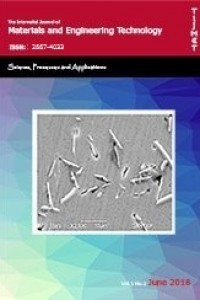EVALUATION OF ANTISLIP PROPERTIES OF CERAMIC-POLYMER COMPOSITE COATING ON CERAMIC TILES
EVALUATION OF ANTISLIP PROPERTIES OF CERAMIC-POLYMER COMPOSITE COATING ON CERAMIC TILES
Antislip coating, polyurethane-ceramic composite, ceramic tiles,
___
- REFERENCES [1] Sanchez, E. Ibanez M.J, Porcelain Tile Microstructure: Implications for Polished Tile Properties, J. Eur. Cer. Soc., 26 (2006) 2533-2540. https://doi.org/10.1016/j.jeurceramsoc.2005.06.002.
- [2] Menezaggo, A.P.M. Paschoal, J.O.A. Evaluation of The Technical Properties of Porcelain Tile And Granite, Qualicer VII World Congress on Ceramic tile Quality, III Castelloon (2002) 211-230.
- [3] Esposito, L. The Reliability of Polished Porcelain Stoware Tiles, J. Eur. Cer. Soc.25 (2005) 1487-1498. https://doi.org/10.1016/j.jeurceramsoc.2004.05.030.
- [4] Sanchez, E. Ibanez M.J. Porcelain Tile Polishing I.Wear Mechanism, Am. Cer. Soc. Bull. 81.No.9, (2002) 50-54.
- [5] Esposito, L. Tucci, A. Wear Resistance of Porcelain Stoneware of Porcelain Stoneware Tiles, Key Engineering Materials (2002) 1759-1762. DOI:10.4028/www.scientific.net/KEM.206-213.1759
- [6] Aydin, H. Ekmekci, I. Isi Yalitim Malzemesi Olarak Poliuretan Kopugun Fiziksel Ve Kimyasal Ozellikleri Uretimi ve Incelenmesi, SAU Fen Bilimleri Enstitusu Dergisi 6(1) (2002) 45-50.
- [7] Zlatanic, A. Cava, C. Zhang, W. Petrovic, Z.S. Effect of structure on properties of polyols and polyurethanes based on different vegetable oils, Journal of Polymer Science Part B: Polymer Physics 42 (2004) 809-819. DOI: 10.1002/polb.10737
- [8] Bektasoglu, S. Plastik Isleme Sanayi Urünleri Raporu, T.C. Basbakanlık Dis Ticaret Müstesarligi Ihracati Gelistirme Etud Merkezi (2005).
- [9] Sadoh, T. Nakato, K. Surface Properties of Wood Physical and Sensory Aspects, Wood Science and Technology 21 (1987) 111-120. [10] Besergil, B. Polimer Kimyası, Gazi Kitabevi, Ankara, 2008, pp 29-31.
- [11] Sengupta, A. Schreiber, H. P. Surface characteristics of polyurethane adhesive formulations, Journal of Adhesion Science and Technology 5(11) 1991 947-957. https://doi.org/10.1163/156856191X00864.
- [12] Chen, A.T. Wojcik, R.T. Polyurethane coatings for metal and plastic substrates, Metal Finishing 98(6) (2000) 143-154. https://doi.org/10.1016/S0026-0576(10)80220-X.
- [13] Ching, Y.C. Syamimie, N. Effect of Nanosilica Filled Polyurethane Composite Coating on Polypropylene Substrate, Journal of Nanomaterials (2013) 1-8. http://dx.doi.org/10.1155/2013/567908.
- [14] Coskun, G. Sariisik, G. Dogal Taslarin Surtunme Katsayilarini (COF) Belirleyerek Yuzey Ozelliklerinin Kayma Guvenlik Risk Analizi, Cumhuriyet Universitesi Fen Fakultesi Fen Bilimleri Dergisi (CFD) 38(2) (2017).
- [15] Szycher, M. Structure–Property Relations in Polyurethanes from: Szycher's Handbook of Polyurethanes, CRC Press, 2012, pp 41-85.
- Yayın Aralığı: Yılda 2 Sayı
- Başlangıç: 2018
- Yayıncı: Necip Fazıl YILMAZ
INVESTIGATION OF THE EFFECT OF CARBONATION CAKE ON RHEOLOGICAL PROPERTIES OF BITUMINOUS BINDERS
Ahmet Münir ÖZDEMİR, Erkut YALÇIN, Hasan ARSLANOĞLU, Mehmet YİLMAZ, Baha KÖK
HARD ANODIC OXIDATION OF A356 ALUMINUM ALLOY
Aziz Barış BAŞYİĞİT, Halil KURT
COMPARISON OF FIVE DEVELOPED POWER CYCLES IN THE FRAME OF WASTE HEAT RECOVERY
Alperen TOZLU, Aysegul ABUSOGLU, Emrah ÖZAHİ
EVALUATION OF ANTISLIP PROPERTIES OF CERAMIC-POLYMER COMPOSITE COATING ON CERAMIC TILES
Neslihan TAMSÜ SELLİ, Fatma DUMAN, Tuğçe YAGYEMEZ
Ahmet ERKLİĞ, Zeynal Abidin OĞUZ, Ömer Yavuz BOZKURT
Uğur AYBARÇ, M.ozgur SEYDİBEYOGLU
Aziz Barış BAŞYİĞİT, Necip CAMUŞCU
INVESTIGATION OF ACTIVE FAILURE SURFACES OCCURRING BEHIND THE T TYPE CANTILEVER RETAINING WALL
Hakan Alper KAMİLOĞLU, Fatih YILMAZ, Erol ŞADOĞLU
